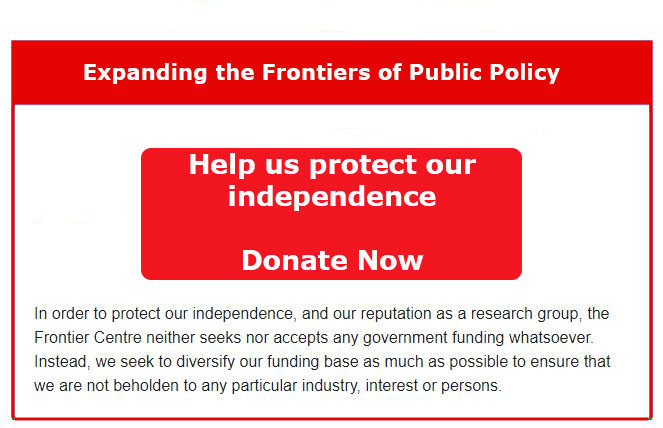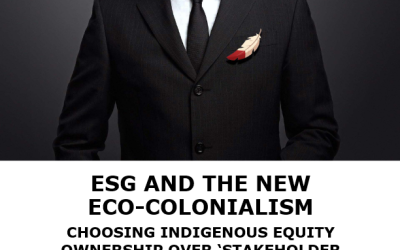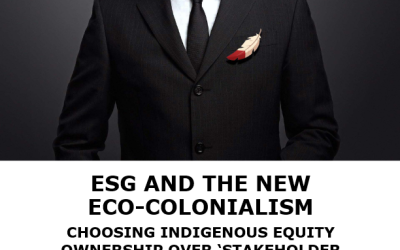There is little doubt that the condition of Indigenous people is desperate in Canada, especially for those living in the 600 or so small isolated First Nations communities.
Most Canadians know some facts about the quality of lives of the people in these communities, but let’s refresh our minds with a few statistics.
First Nations have the highest rates of incarceration, homelessness, poverty, and welfare dependency. They also have the highest rates of infant mortality, suicides, and the lowest life expectancy of any racial or ethnic group in Canada. As well, reserve communities have the highest rates of sexual abuse, single motherhood, and alcohol and drug abuse.1
This litany of disadvantages is depressing to all right-thinking Canadians. While many people remember some of these facts, hardly anyone knows what to do about the poor living conditions of these people.
There are, however, at least three policies that have been put forward by the Federal government or First Nations’ leaders to improve the situation. All three, unfortunately, won’t help the people living in these communities.
First, the Federal government seems to think that spending more money is the best way to deal with living conditions on First Nations. But Tom Flanagan reports there has been a huge increase in the spending on Indigenous people over the last 10 to 15 years with little—or no—improvements in the quality of their lives.2
Second, Bill C-15 has recently been introduced in the House of Commons. C-15 recommends that the Federal government accept the United Nations Declaration on the Rights of Indigenous People (UNDRIP), which outlines the way that the United Nations expects countries to treat their Indigenous people.3 This declaration proclaims that: “the rights affirmed in treaties, agreements and other constructed arrangements between States and indigenous peoples are, in some situations, matters of international concern, interest, responsibility and character.”4
As expected, Chief Perry Bellegarde, National Chief of the Assembly of First Nations, has claimed that when this declaration passes into Canadian law, it will get First Nation people much closer to self-determination than they are at present. To Chief Bellegarde, “The declaration is a tool for building a better relationship with Canada, in which treaty rights will be affirmed, respected and upheld.”5
But, if you read this declaration, you will see that it will only ensure that the United Nations becomes involved in negotiations taking place between Indigenous people and Canadian governments from the municipal to the federal levels. Thus, even from this short quotation, it is obvious that the court of last appeal will become the United Nations. If C-15 passes, Canada will be surrendering a considerable amount of its sovereignty to an international organization of questionable competence.6
Canadians should ask Lieutenant-General Romeo Dallaire how much faith he has in the United Nations in making sensible and just decisions about the lives of vulnerable people.7
Finally, the Truth and Reconciliation Commission has said that approving the 94 Calls to Action in its Report will lift the tremendous burden of poverty off the shoulders of Indigenous people. But like UNDRIP, a close reading of these 94 Calls shows that they ask non-Indigenous people to spend increasingly more resources on Indigenous people without any assurance that the results will be accepted.
Three Calls to Action illustrate what is being requested—or demanded:
16 We call upon post-secondary institutions to create university and college degree and diploma programs in Aboriginal language.
19 We call upon the federal government, in consultation with Aboriginal peoples, to establish measurable goals to identify and close the gaps in health outcomes between Aboriginal and non-Aboriginal communities and to publish annual progress reports and assess long-term trends.
24 We call upon medical and nursing schools in Canada to require all students to take a course dealing with Aboriginal health issues, including the history and legacy of residential schools, the United Nations Declaration on the Rights of Indigenous People, Treaties and Aboriginal rights, and Indigenous teachings and practices.8
These requests sound a lot like what the Federal government has been attempting to do since the White Paper was rejected over 50 years ago—that is, spending increasingly more money hoping that something positive will happen, but seeing that, in reality, very little has changed in the quality of the lives of Indigenous people living in First Nations communities.
Most importantly, there is nothing in the Calls to Action that indicates that Indigenous and non-Indigenous people will respond in mutually beneficial ways.
Why?
Because these Calls are, in fact, demands, and there is no obligation for Indigenous people to respond in a positive way even if all the demands are fulfilled.
The TRC Report says that if an Indigenous person does not “feel” enough has been done, or if non-Indigenous people have not been sincere enough, then reconciliation has not resulted. According to the Report, reconciliation can only be achieved when every Indigenous person feels satisfied.
Of course, self-respect and self-determination cannot be gained from demanding that other people spend money on you. Fundamentally, these human traits can only be sustained by doing things for oneself.
Thus, the 94 Calls to Action in the TRC Report are a pipe dream—a dream that will never come true because they continue the dependency that has caused many of the problems in the first place. Thus, the TRC Report recommends a continuation of the paternalistic, top-down, relationship between Indigenous and non-Indigenous people that has created the present intractable situation.
So, it seems that the three proposals now on the table are unlikely to improve the lives of Indigenous people.
But is there anything that can be done?
Yes, there is one plan that could make a difference.
In the 2020 throne speech, Prime Minister Justin Trudeau said that he was planning to establish a wealth tax. His specific words were: “The Government will also identify additional ways to tax extreme wealth inequality.”9
A couple of years earlier, a scheme for helping poor people overcome poverty was suggested by Conrad Black, and it could easily be adapted to address the pressing needs of First Nations people.10
Black suggests that a wealth tax of 2 percent could be levied against Canadians with a net worth of $10 million or more. So, for example, an individual with a net worth of $10 million would be assessed $200,000 in wealth taxes. This person could then choose to pay the tax or invest the money in businesses and/or services that would help Indigenous communities.
A pressing need on many First Nations is employment opportunities. Because the financially successful people could benefit from their investments, they will have an incentive to work with First Nations people, spending their time and talent in helping develop and manage businesses and services on First Nations.11
While these wealthy Canadians will be investing their money, time, and talent, Indigenous people and communities will be investing resources too. These mutual investments will create reciprocal obligations between two groups of people each with different resources and needs.
As the programs prospered, the income earned would be split in a fair way between the investors, the Indigenous employees, and the communities. The income earned by the non-Indigenous investors would be taxed as income, but the Indigenous employees would pay no income tax if they were working or living on First Nations lands.
If the businesses or services failed, the wealth tax would be charged the next year and would go to the government. Thus, there would be reciprocal incentives to turn First Nations’ human and physical resources into assets that would benefit Indigenous people.
In the words of Lord Black, “In this way, the most commercially and financially astute people in society would have a vested interest in the elimination of poverty and the interests of the wealthiest and the poorest people in society would be exactly aligned.”12
Building viable businesses and services on First Nations is the best way of building self-respect, self-determination, and self-reliance. It is also the best way of building cooperation between Canadians from different sectors of society.
Because of the alignment of incentives and the tax rebates, it is likely that Indigenous people would become gainfully employed and eventually they would prosper. This scheme is much more likely to work than pouring money into First Nations communities without any accountability, accepting the obligations in the UNDRIP declaration, or fulfilling all 94 Calls to Action in the TRC Report.
Bob McDonnell, the former governor of Virginia, claimed “Jobs are what give people a sense of fulfillment and self-reliance.” In other words, to Conrad Black the best anti-poverty program is a meaningful job. Along with meaningful work, substantial improvements in individuals, families, and communities will follow.
So far, this is the most viable way forward for Indigenous people and their communities.
Rodney A. Clifton is a professor emeritus at the University of Manitoba and a senior fellow at the Frontier Centre for Public Policy. (rodney.clifton@umanitoba.ca). His most recent book, edited with Mark DeWolf, is From Truth Comes Reconciliation: An Assessment of the Truth and Reconciliation Commission Report (Winnipeg, MB, Frontier Centre for Public Policy, 2021).
[show_more more=”SeeEndnotes” less=”Close Endnotes”]
- Hymie Rubenstein, “Indigenous exceptionalism and the TRC.” In From Truth Comes Reconciliation: Assessing the Truth and Reconciliation Commission Report, ed. Rodney A. Clifton and Mark DeWolf (Winnipeg: Frontier Centre for Public Policy, 2021), 148-169. See also Jonathan Kay, “The Case for Assimilation (Part I),” National Post, December 8, 2001. http://www.bluecorncomics.com/stype1c7.htm.
- Tom Flanagan, Promise and Performance: Recent Trends in Government Expenditures on Indigenous People, Fraser Forum, January 26, 2021.
- Brian Giesbrecht, “A legal perspective on the TRC Report.” In From Truth Comes Reconciliation: Assessing the Truth and Reconciliation Commission Report, ed. Rodney A. Clifton and Mark DeWolf (Winnipeg, MB: Frontier Centre for Public Policy, 2021), 170-188.
- See the United Nations Declaration on the Rights of Indigenous Peoples, https://www.un.org/development/desa/indigenouspeoples/declaration-on-the-rights-of-indigenous-peoples.html.
- The Canadian Press, “New law will help achieve Indigenous self-determination,” The Winnipeg Free Press, February 11, 2021, A9.
- Giesbrecht, “A legal perspective ,” 181-86.
- Romeo Dallaire and Brent Beardsley, Shake Hands with the Devil: The Failure of Humanity in Rwanda (Toronto: Random House, 2003).
- Truth and Reconciliation Commission of Canada, Canada’s Residential Schools: Reconciliation, Vol. 6 (Montreal, McGill-Queen’s University Press, 2015), 223-41.
- https://www.canada.ca/en/privy-council/campaigns/speech-throne/2020/speech-from-the-throne.html.
- Conrad Black, The Canadian Manifesto: How one Frozen Country can Save the World (Toronto: Sutherland House, 2018), 92-94.
- The proposal is just sketched out here and would need to be developed much further before it could be implemented.
- Black, The Canadian Manifesto, 93.
[/show_more]
Photo by Alvaro Reyes on Unsplash.



